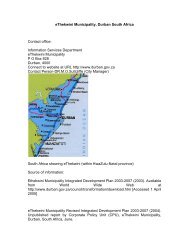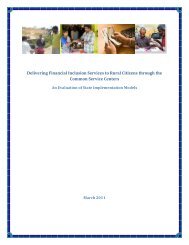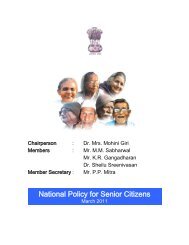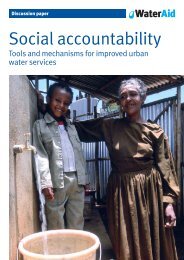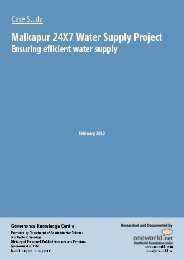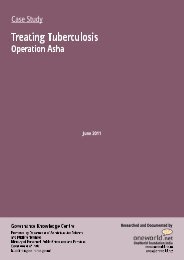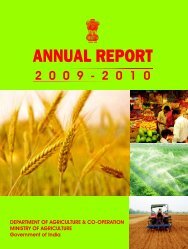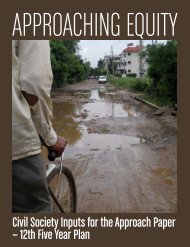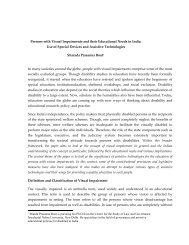EMRI model - Indiagovernance.gov.in
EMRI model - Indiagovernance.gov.in
EMRI model - Indiagovernance.gov.in
You also want an ePaper? Increase the reach of your titles
YUMPU automatically turns print PDFs into web optimized ePapers that Google loves.
Study of Emergency Response Service (<strong>EMRI</strong> Scheme)The ball park figure from <strong>in</strong>ternational studies, quoted <strong>in</strong> the <strong>EMRI</strong>s feasibility report is8% medical emergencies annually – or <strong>in</strong> other words 8000 emergencies <strong>in</strong> a populationof 1 lakh or about 22 medical emergencies per day.How many ambulances would be needed?This is another question that states are fac<strong>in</strong>g. The norm, that <strong>EMRI</strong> is us<strong>in</strong>g, is one perlakh population. Both Gujarat and Andhra have projected 100% coverage with thenumber of ambulances, as shown <strong>in</strong> Table 1, but they may be short of this norm of oneper lakh by 25%. If we count the 150 ambulances added s<strong>in</strong>ce December, then AndhraPradesh would have achieved the norm. However we know that a) Andhra Pradesh hassought another 300 ambulances to achieve 100% coverage and b) that currently by itsown estimate it is reach<strong>in</strong>g only 32% of all emergencies. If achiev<strong>in</strong>g an ideal time ofresponse is a mandatory part of the def<strong>in</strong>ition then it has implications for declar<strong>in</strong>g theachievement of 100% coverage. There are two factors that <strong>in</strong>fluence promptness ofresponse – the first is geography and the second is rate of utilisation. Thus on a roadwhich allows an average of 60km per hour (national highway <strong>in</strong> the Indian context) thatwould mean an ambulance has to be stationed with<strong>in</strong> 40 km of every habitation. If theroads are such that it allows only an average of 30km per hour (all village roads, hillyterra<strong>in</strong> and non-metalled roads) than we need an ambulance with<strong>in</strong> every 20 km of everyhabitation. If this is the target, then, even 1100 ambulances <strong>in</strong> Andhra would not be ableto delivery that, though it would be nearer to it. Rajasthan has now only 21% coveragewith 100 ambulances, all of which is urban or semi-urban. Should it aim to cover thesparsely <strong>in</strong>habited desert areas on a 40 m<strong>in</strong>ute norm and create more affordable normsfor such areas? How much should it aim for given its deserts and tribal regions? InGujarat, how many ambulances should be deployed <strong>in</strong> Kutch as compared to Mehsanadistrict? But <strong>in</strong> the desert or tribal areas with dispersed small size habitations, if thenumber of ambulances per lakh population decreases, then utilization per ambulancewould fall and subsequently the unit cost would rise.We note that currently <strong>EMRI</strong> is allowed to set a po<strong>in</strong>t as nearest road pick-up po<strong>in</strong>t forevery habitation and the 40–m<strong>in</strong>utes response time is counted to that po<strong>in</strong>t. Thediscretion on locat<strong>in</strong>g these pick up po<strong>in</strong>ts and even of locat<strong>in</strong>g the ambulances itself iswith <strong>EMRI</strong> and has been done with the guidance from GIS <strong>in</strong>puts and some consultationwith the department.The other factor <strong>in</strong> decid<strong>in</strong>g on number of ambulances is utilisation. <strong>EMRI</strong> reports thatabove a frequency of 8 patients per day, delays become frequent because of ambulancebe<strong>in</strong>g busy with another case or with repairs and ma<strong>in</strong>tenance. An ambulance couldachieve such a rate of utilisation with<strong>in</strong> two or three years of its operation. One wouldtherefore necessarily have to add a second ambulance after two to three years <strong>in</strong>to thesame population- a phenomenon that is clearly seen <strong>in</strong> places like Nellore where theprogramme is <strong>in</strong>to its fourth year. A second ambulance <strong>in</strong> the same lakh populationNational Health Systems Resource Centre (NHSRC)22




